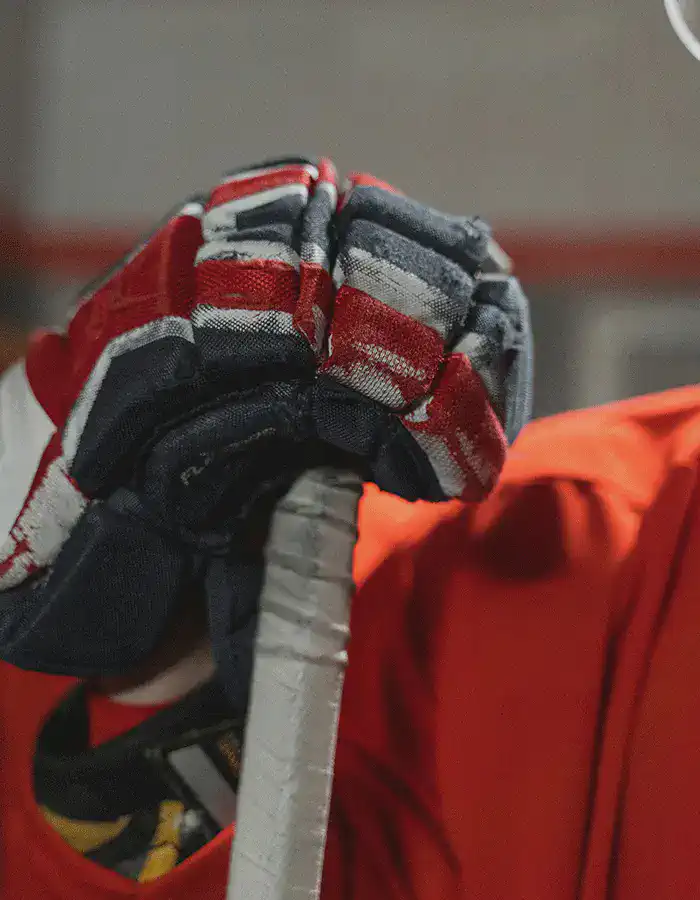In the fast-paced world of hockey, cleanliness often takes a backseat to the adrenaline rush of the game. However, maintaining clean hockey gear is not just about aesthetics; it’s crucial for hygiene, odor control, and prolonging the lifespan of your equipment. Dive into the art of washing hockey gear with us as we explore essential tips and best practices to keep your gear fresh and in top-notch condition.
How to wash hockey gear: keep the outfit clean
Hockey, the adrenaline-packed sport loved by many, demands both skill and dedication. However, amidst the thrill of the game, one crucial aspect often gets overlooked – cleaning your hockey gear. Beyond just aesthetics, maintaining clean gear is paramount for hygiene, odor control, and extending the lifespan of your equipment. Let’s delve into the art of washing hockey gear and explore the best practices to keep your gear fresh and in top-notch condition.

Washing different gear:
- Helmet:
Your helmet serves as a crucial safeguard, protecting your head from potential injuries. Within it lies a removable liner, which accumulates sweat and bacteria over time. To wash it effectively, gently remove the liner and follow manufacturer guidelines for washing. Typically, handwashing with mild detergent and air-drying is recommended to preserve its integrity and ensure thorough cleaning.
- Gloves:
Hands are the primary tool in hockey, and gloves are their armor. Whether you opt for hand washing or machine washing depends on the material of your gloves. While machine washing may seem convenient, delicate materials may require the gentler touch of handwashing. Use lukewarm water and mild detergent, ensuring thorough rinsing to remove any soap residue that could irritate your skin during gameplay.
- Shin pads:
Shin pads endure relentless impacts and sweat accumulation during gameplay. Spot cleaning them regularly with a damp cloth and mild detergent can effectively remove dirt and odor. After cleaning, ensure thorough drying to prevent mold and mildew growth. Pro tip: Remove any removable inserts and air-dry them separately to expedite the drying process.
- Pads:
From shoulder pads to knee pads, these protective gears absorb copious amounts of sweat, leading to stubborn odor buildup. To combat this, consider using specialized odor-eliminating solutions during the washing process. Additionally, opt for antibacterial detergents to ensure a thorough cleanse and mitigate bacterial growth. After washing, air-dry your pads thoroughly in a well-ventilated area to prevent moisture retention.
General cleaning tips:
- Disinfectant solutions:
Incorporating disinfectant solutions into your cleaning routine can effectively eliminate germs and bacteria, safeguarding you against potential infections. However, exercise caution and adhere to recommended dilution ratios to prevent skin irritation and equipment damage. Always spot-test any disinfectant solution on a small, inconspicuous area before widespread application.
- Drying methods:
Proper drying is pivotal in preventing mold, mildew, and foul odors from plaguing your gear. While air-drying is the preferred method, certain gear may benefit from low-heat machine drying. Ensure adequate airflow by hanging gear in well-ventilated areas, avoiding direct sunlight to prevent material degradation. For expedited drying, consider utilizing fans or dehumidifiers in damp environments.
- Storage solutions:
The battle against moisture doesn’t end with cleaning and drying; proper storage is equally crucial. Invest in breathable mesh bags or ventilated gear racks to promote airflow and prevent moisture buildup. Avoid storing gear in confined spaces or sealed containers, as these conditions foster bacterial growth and odor retention.
How cold is a Hockey game? Understanding the temperature inside an ice rink
How cold can a hockey game get? Here we take a look at the factors that affect arena temperatures, the average temperature range and tips on how to stay comfortable in the cold.
Factors affecting temperature:
Arena temperature regulation systems:
- Modern hockey arenas employ sophisticated temperature regulation systems to maintain optimal conditions for both players and spectators. These systems include heating, ventilation, and air conditioning (HVAC) units, ensuring consistent temperatures regardless of external weather conditions.
Player activity and heat generation:
- The vigorous physical exertion exerted by hockey players generates substantial heat, counteracting the chilly ambient temperatures within the arena. As players skate, pass, and shoot, their bodies produce warmth, contributing to a slightly higher temperature on the ice and within the player benches.
Spectator presence and impact on arena temperature:
- The presence of spectators further influences arena temperature dynamics. Crowded stands can lead to localized increases in temperature due to body heat emanating from the audience. However, the overall effect on arena temperature is minimal, as modern HVAC systems efficiently regulate and maintain consistent temperatures throughout the facility.
The average temperature range experienced during a hockey game typically falls between 45°F to 60°F (7°C to 15.5°C). This range provides a comfortable environment conducive to gameplay while preventing excessive heat buildup that could impede player performance.
In contrast to outdoor temperatures, which can vary significantly depending on geographical location and time of year, the controlled environment of a hockey arena offers a more predictable and moderate climate. While outdoor temperatures may plummet to freezing or below, indoor arenas provide a regulated climate that ensures a consistent playing experience for athletes and spectators alike.

Tips for staying comfortable:
Dressing in layers:
- Layering clothing is essential for adapting to fluctuating temperatures within the arena. Start with a moisture-wicking base layer to keep sweat at bay, followed by insulating layers such as a fleece or thermal shirt. Finally, top it off with a waterproof and windproof outer layer to shield against drafts and maintain warmth.
Bringing hand warmers or other heat sources:
- Hand warmers, portable heaters, or insulated blankets can provide additional warmth during extended periods of spectatorship. Tucking hand warmers into pockets or gloves can help combat chilly fingers, while portable heaters offer targeted heat for seating areas.
What should I wear to a hockey game? Tips for dressing appropriately
Attending a hockey game is not just about witnessing the thrill of the sport; it’s also about ensuring your comfort throughout the game. Selecting the appropriate attire can make all the difference between an enjoyable experience and feeling uncomfortably cold. Let’s explore the ideal wardrobe choices for a hockey game.
Recommended Attire:
Base layers for warmth and moisture wicking:
- Start with a moisture-wicking base layer to keep sweat away from your skin, ensuring you stay dry and comfortable throughout the game. Choose materials like polyester or merino wool for optimal moisture management.
Insulating layers for added warmth (Optional):
- Depending on the temperature inside the arena and your personal comfort level, consider adding insulating layers such as a fleece jacket or sweater. These layers trap heat close to your body, providing an extra barrier against the cold.
Outerwear options (Jackets, Hats, Gloves):
- A warm, insulated jacket is essential for keeping the chill at bay, especially if you’ll be sitting close to the ice. Don’t forget to bring a hat and gloves to protect your extremities from the cold. Opt for materials like fleece or wool for maximum warmth.
Footwear considerations (Comfortable Shoes or Boots):
- Comfortable footwear is key to enjoying the game without any discomfort. Choose shoes or boots with good insulation and traction, especially if you’ll be walking through snow or ice to reach the arena.
Additional tip:
- Team Spirit and Colors (Optional):
For die-hard fans, showing support for your favorite team through your clothing choices can add to the excitement of attending a hockey game. Consider wearing team jerseys, scarves, or hats in your team’s colors to showcase your enthusiasm.
How much does a hockey puck weigh? Details on size and weight standards
The hockey puck, a small but essential component of the game, plays a significant role in gameplay dynamics. Understanding its weight is crucial for players, officials, and enthusiasts alike. Let’s explore the official weight of a hockey puck and the factors influencing its composition.
The official weight of a hockey puck is standardized across various leagues and competitions. It typically weighs 6 ounces (170 grams), ensuring consistency in gameplay and equipment specifications. This standardized weight allows for fair and uniform gameplay, regardless of the level of competition.
Hockey pucks are primarily constructed from vulcanized rubber, a durable material known for its resilience and impact resistance. The vulcanization process involves subjecting rubber to heat and pressure, resulting in a dense, solid puck capable of withstanding the rigors of gameplay.
Impact of material on weight and performance
The choice of material significantly influences the weight and performance of a hockey puck. Vulcanized rubber offers the ideal balance of weight, durability, and bounce characteristics, ensuring optimal gameplay on various surfaces, including ice and synthetic rinks. Additionally, the uniformity of puck weight enables consistent puck handling, shooting, and passing skills development among players.
In conclusion, the standardized weight of a hockey puck, coupled with its durable vulcanized rubber construction, ensures fair and consistent gameplay across all levels of competition. Understanding the significance of puck weight enhances players’ skills and contributes to the overall enjoyment of the game for players and spectators alike.
How to measure a Hockey stick: Finding your perfect fit
Selecting the right hockey stick is essential for players of all levels. The stick’s length directly impacts your performance on the ice, influencing your stickhandling, shooting accuracy, and overall comfort during gameplay. In this guide, we’ll explore various methods for measuring a hockey stick to help you find the perfect fit.
Measuring methods:
Standing measurement technique:
- One of the most common methods for measuring a hockey stick involves standing it upright next to your body. To do this, stand in your hockey skates with the stick’s blade on the ground and the shaft running alongside your body. Ideally, the stick’s top end should reach somewhere between your chin and nose. This measurement ensures proper control and maneuverability during gameplay.
Lie-to-board measurement technique:
- Another method involves lying the stick flat on the ground and positioning a measuring board perpendicular to it. Then, place the blade of the stick against the board and extend the shaft up to your body. The ideal length is where the stick’s shaft intersects with your nose or chin. This technique provides a precise measurement and is commonly used by equipment specialists.

Age and height recommendations for stick length:
- While these measurement techniques offer general guidelines, age and height also play significant roles in determining the appropriate stick length. Younger players or those of shorter stature may benefit from shorter sticks, while taller players may require longer sticks for optimal performance. Below are some general recommendations:
- Youth players (ages 3-5): Stick length should reach the chin or slightly below.
- Junior players (ages 6-12): Stick length should range from the chin to the nose.
- Adult players: Stick length typically falls between the nose and chin.
It should be noted that the standard ice thickness of a hockey rink serves as the foundation for safe and enjoyable play. By adhering to regulatory standards and implementing effective maintenance practices, rink operators can ensure that the ice remains in perfect condition, promoting fast-paced action and memorable moments on the ice.
Exploring the depths: How thick is the ice on a Hockey rink?
The quality of ice on a hockey rink is fundamental to the integrity of the game. From providing a smooth surface for fast-paced action to ensuring player safety, the thickness of the ice plays a critical role. In this article, we’ll delve into the standard thickness of ice on a hockey rink and the factors influencing its maintenance.
The standard thickness of ice on a hockey rink typically ranges from 3/4 inches to 1 inch (1.9 to 2.5 centimeters). This specific thickness is meticulously maintained to meet regulatory standards set by governing bodies such as the International Ice Hockey Federation (IIHF) and the National Hockey League (NHL). The reasons for this specific thickness are twofold:
- A sufficient thickness of ice is essential to support the weight of players, referees, and equipment without risk of cracking or breaking. Thicker ice provides a stable foundation for gameplay and reduces the likelihood of injuries caused by uneven surfaces.
- Optimal ice thickness ensures consistent puck movement and player agility during gameplay. Thicker ice minimizes friction and allows for smoother skating, passing, and shooting, enhancing the overall quality of the game.
Despite meticulous maintenance efforts, several factors can influence ice thickness throughout a game. These include ambient temperature, humidity levels, and player activity. Warmer temperatures and high humidity can cause the ice to melt slightly, affecting its thickness and consistency. Additionally, the constant movement and impact of players’ skates and sticks can gradually wear down the ice surface over time, necessitating periodic resurfacing to maintain optimal conditions. You can also find useful information on our blog about the major events of 2024 and the basic rules of hockey.
Conclusion
From the meticulous care of your gear to the thrill of attending a game, hockey encompasses a world of excitement and dedication. By mastering the art of washing your gear, dressing appropriately for games, and understanding key elements like puck weight and ice thickness, you’re well-equipped to enhance your enjoyment of the sport. Whether you’re a player, spectator, or enthusiast, let this guide be your companion in navigating the thrilling world of hockey with confidence and style.